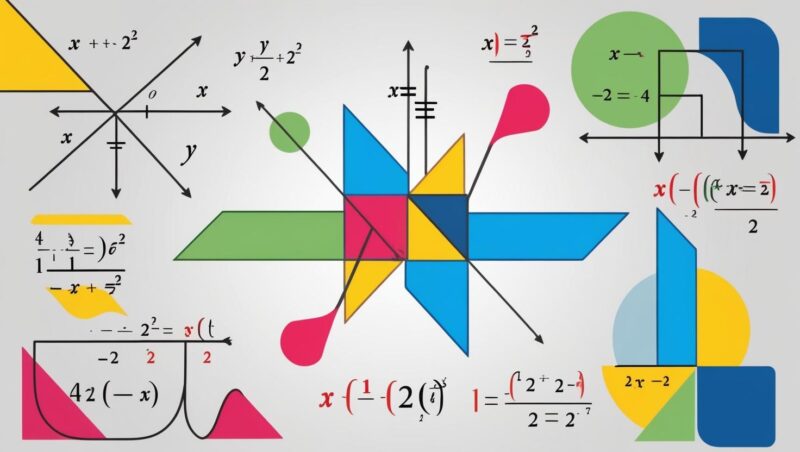
Share Post:
Every app you use, every algorithm that suggests videos on YouTube, and every financial forecast relies on mathematical models — and a lot of that math is rooted in Algebra 2.
Beyond academics, knowing Algebra 2 gives you the critical thinking skills to break down complex problems and find logical solutions.
It’s about applying mathematical concepts to real-life scenarios, interpreting data, and preparing yourself for careers in technology, science, engineering, finance, and more.
So whether you’re planning to become an engineer, a data scientist, or just want to conquer your math class without losing your mind, mastering Algebra 2 is crucial.
Mastering Functions: The Foundation of Algebra 2
Let’s get into the meat of it: functions. Think of functions as math’s way of saying, “Give me a number, and I’ll tell you what comes out.”
Functions take an input (x) and give an output (y). They are fundamental because they model relationships between variables.
Types of Functions You Need to Know
1. Linear Functions
These are the simplest and most straightforward functions. They graph as straight lines and follow the form:
y=mx+by = mx + by=mx+b Here:
Example:
Let’s say you’re tracking your savings. You save $50 every week, and you start with $200. Your savings function would be:
y=50x+200y = 50x + 200y=50x+200
This means after one week (x=1x=1x=1), you have $250 saved. After four weeks (x=4x=4x=4), you have $400.
Tips for Mastery:
Memorize the slope formula:
m=y2−y1x2−x1m = \frac{y_2 – y_1}{x_2 – x_1}m=x2−x1y2−y1
- Practice graphing from both the slope-intercept and point-slope forms.
- Learn how to quickly find x- and y-intercepts by setting the opposite variable to zero.
2. Quadratic Functions
Quadratic functions graph as parabolas (U-shaped curves) and have the form:
y=ax2+bx+cy = ax^2 + bx + cy=ax2+bx+c
- If a is positive, the parabola opens upwards.
- If a is negative, it opens downwards.
Vertex Form:
The vertex form makes it easier to see the turning point of the parabola:
y=a(x−h)2+ky = a(x – h)^2 + ky=a(x−h)2+k
Example:
Imagine a basketball being shot in an arc. The function:
y=−2(x−5)2+10y = -2(x – 5)^2 + 10y=−2(x−5)2+10
The vertex (5,10)(5, 10)(5,10) tells you the highest point of the ball is at 10 feet when it’s 5 feet horizontally from the player.
Mastering Quadratics:
- Factoring: Break down the quadratic into two binomials.
- Completing the Square: Reformat to vertex form when factoring doesn’t work.
Quadratic Formula: Use when factoring is impossible:
x=−b±b2−4ac2ax = \frac{-b \pm \sqrt{b^2 – 4ac}}{2a}x=2a−b±b2−4ac
Discriminant Insight: The part under the square root (b2−4acb^2 – 4acb2−4ac) tells you the number of real solutions:
- Positive: 2 solutions
- Zero: 1 solution
- Negative: No real solutions (but you’ll have complex numbers)
3. Polynomial Functions: The Powerhouses of Algebra 2
A polynomial function is a mathematical expression that combines variables and coefficients using addition, subtraction, multiplication, and non-negative integer exponents. The general form of a polynomial function looks like this:
P(x)=anxn+an−1xn−1+⋯+a1x+a0P(x) = a_nx^n + a_{n-1}x^{n-1} + \dots + a_1x + a_0P(x)=anxn+an−1xn−1+⋯+a1x+a0
Where:
- an,an−1,…,a0a_n, a_{n-1}, \dots, a_0an,an−1,…,a0 are constants (coefficients).
- nnn is a non-negative integer (degree).
- The coefficient ana_nan at the highest power is called the leading coefficient.
- The term with the highest power (xnx^nxn) dictates the degree of the polynomial.
Examples of Polynomial Functions:
Linear Polynomial (Degree 1):
P(x)=3x+2P(x) = 3x + 2P(x)=3x+2
Graph: A straight line with slope 3.
Quadratic Polynomial (Degree 2):
P(x)=2×2−5x+3P(x) = 2x^2 – 5x + 3P(x)=2×2−5x+3
Graph: A parabola that opens upward because the coefficient of x2x^2×2 is positive.
Cubic Polynomial (Degree 3):
P(x)=x3−3×2+2xP(x) = x^3 – 3x^2 + 2xP(x)=x3−3×2+2x
Graph: A curve that twists and crosses the x-axis up to three times.
Quartic Polynomial (Degree 4):
P(x)=x4−6×3+11×2−6xP(x) = x^4 – 6x^3 + 11x^2 – 6xP(x)=x4−6×3+11×2−6x
Graph: A curve with up to four x-intercepts and three turning points.
Why Degree Matters:
The degree of the polynomial tells you two very important things:
- Number of Roots (Solutions): A polynomial of degree nnn has up to nnn roots.
- Example: A cubic polynomial (degree 3) has up to three roots.
- Number of Turning Points: The maximum number of turning points is n−1n – 1n−1.
- Example: A quartic polynomial (degree 4) can have up to three turning points.
4. Rational Functions
These are fractions where the numerator and denominator are both polynomials. They often have asymptotes (lines the graph approaches but never touches).
- Vertical Asymptotes: Occur where the denominator is zero.
- Horizontal Asymptotes: Determined by the degree of the numerator and denominator.
Example:
y=3×2+2x−5×2−4y = \frac{3x^2 + 2x – 5}{x^2 – 4}y=x2−43×2+2x−5
Vertical asymptotes occur at x=±2x = \pm 2x=±2 since the denominator equals zero at those points.
5. Exponential and Logarithmic Functions
Exponential functions show rapid growth or decay: y=a⋅bxy = a \cdot b^xy=a⋅bx Logarithmic functions are the inverse of exponentials: y=logb(x)y = \log_b(x)y=logb(x)
Real-Life Application:
- Exponential functions model population growth or compound interest.
- Logarithms are used to decode exponential equations and in fields like sound intensity measurement (decibels) and pH in chemistry.
Complex Numbers: Breaking Reality
Let’s talk about something that might seem downright impossible at first: complex numbers. These numbers help us deal with equations that don’t have real solutions.
You’ve probably encountered a quadratic equation that just didn’t seem to work out — like trying to take the square root of a negative number. In the real number system, that’s a dead end.
But complex numbers give us a way out.
The Basic Unit: Imaginary Number (i)
This little letter i is what makes complex numbers tick. It’s not something mystical — it’s just a mathematical tool that lets us expand our number system to handle previously unsolvable problems.
Structure of a Complex Number
A complex number has two parts: 3+4i3 + 4i3+4i Here:
Together, a complex number looks like this:
Why Do We Need Complex Numbers?
You might be wondering why anyone would bother with these weird numbers. The answer is simple: without complex numbers, many equations would be unsolvable. For example: x2+4=0x^2 + 4 = 0x2+4=0 Subtract 4 from both sides: x2=−4x^2 = -4×2=−4 Take the square root of both sides: x=±−4x = \pm \sqrt{-4}x=±−4 Using complex numbers, we can express this as: x=±2ix = \pm 2ix=±2i
Instead of saying the equation has no real solution, we now know it has two complex solutions.
Operations with Complex Numbers
Complex numbers are more than just theoretical curiosities — they have their own arithmetic rules. Let’s break them down.
Addition and Subtraction:
To add or subtract complex numbers, combine the real parts and the imaginary parts separately.
(3+4i)+(5−2i)=(3+5)+(4i−2i)=8+2i(3 + 4i) + (5 – 2i) = (3 + 5) + (4i – 2i) = 8 + 2i(3+4i)+(5−2i)=(3+5)+(4i−2i)=8+2i (6−3i)−(2+4i)=(6−2)−(3i+4i)=4−7i(6 – 3i) – (2 + 4i) = (6 – 2) – (3i + 4i) = 4 – 7i(6−3i)−(2+4i)=(6−2)−(3i+4i)=4−7i
Multiplication:
Multiply complex numbers as if they were binomials, and remember that:
i2=−1i^2 = -1i2=−1
Example:
(2+3i)(1−4i)=2−8i+3i−12i2(2 + 3i)(1 – 4i) = 2 – 8i + 3i – 12i^2(2+3i)(1−4i)=2−8i+3i−12i2
Since i2=−1i^2 = -1i2=−1, it becomes:
2−8i+3i+12=14−5i2 – 8i + 3i + 12 = 14 – 5i2−8i+3i+12=14−5i
Division:
To divide, multiply the numerator and denominator by the conjugate of the denominator to eliminate the imaginary part.
3+4i1−2i\frac{3 + 4i}{1 – 2i}1−2i3+4i Multiply by the conjugate of the denominator: (3+4i)(1+2i)(1−2i)(1+2i)\frac{(3 + 4i)(1 + 2i)}{(1 – 2i)(1 + 2i)}(1−2i)(1+2i)(3+4i)(1+2i) The denominator becomes: 12−(2i)2=1−(−4)=51^2 – (2i)^2 = 1 – (-4) = 512−(2i)2=1−(−4)=5 Expanding the numerator: 3+6i+4i+8i2=3+10i−8=−5+10i3 + 6i + 4i + 8i^2 = 3 + 10i – 8 = -5 + 10i3+6i+4i+8i2=3+10i−8=−5+10i Final result: −5+10i5=−1+2i\frac{-5 + 10i}{5} = -1 + 2i5−5+10i=−1+2i
Graphing Complex Numbers on the Complex Plane
Complex numbers can be visualized on a complex plane, where:
- The x-axis represents the real part.
- The y-axis represents the imaginary part.
The number 3+4i3 + 4i3+4i is plotted at the point (3,4)(3, 4)(3,4). This way, complex numbers become points or vectors in a plane.
Magnitude and Argument
The magnitude (or absolute value) of a complex number is the distance from the origin:
∣3+4i∣=32+42=9+16=5|3 + 4i| = \sqrt{3^2 + 4^2} = \sqrt{9 + 16} = 5∣3+4i∣=32+42=9+16=5
The argument is the angle it makes with the positive x-axis, found using:
θ=tan−1(43)\theta = \tan^{-1} \left(\frac{4}{3}\right)θ=tan−1(34)
This gives us a way to analyze complex numbers geometrically, making it easier to understand operations like multiplication and division as rotations and scalings on the plane.
Elimination:
Multiply one or both equations to line up coefficients, then add or subtract to eliminate a variable.
3x+2y=163x + 2y = 163x+2y=16 2x−2y=42x – 2y = 42x−2y=4 Add the equations: 5x=20 ⟹ x=45x = 20 \implies x = 45x=20⟹x=4 Substituting: 3(4)+2y=16 ⟹ 12+2y=16 ⟹ 2y=4 ⟹ y=23(4) + 2y = 16 \implies 12 + 2y = 16 \implies 2y = 4 \implies y = 23(4)+2y=16⟹12+2y=16⟹2y=4⟹y=2 Solution: (4,2)(4, 2)(4,2)
Matrix Method:
Represent the system as a matrix and use Gaussian elimination or inverse matrices to find the solution.
[322−2][xy]=[164]\begin{bmatrix} 3 & 2 \\ 2 & -2 \end{bmatrix} \begin{bmatrix} x \\ y \end{bmatrix} = \begin{bmatrix} 16 \\ 4 \end{bmatrix}[322−2][xy]=[164]
Solving this matrix gives the same solution as before: (4,2)(4, 2)(4,2).
Mastering Matrices and Determinants
Matrices are grids of numbers used to perform complex calculations. You’ll encounter them in:
- Data Science: Organizing and transforming data.
- Computer Graphics: Rotating and scaling objects.
- Engineering: Solving multiple equations simultaneously.
Basic Operations:
- Addition and Subtraction: Combine corresponding elements.
- Multiplication: Multiply rows by columns (dot product).
- Determinant: Calculate to check matrix convertibility.
- Inverse: Find the reciprocal matrix to solve systems.
Determinant Calculation:
[abcd]\begin{bmatrix} a & b \\ c & d \end{bmatrix}[acbd] The determinant is: ad−bcad – bcad−bc
Final Thoughts
Algebra 2 is more than just solving equations — it’s about interpreting data, predicting outcomes, and breaking down complex relationships.
Whether you’re coding algorithms, analyzing statistics, or engineering solutions, these concepts are your foundation.
Keep practicing, stay curious, and never hesitate to experiment with different problem-solving approaches. You’ve got this!
Related Posts:
- Algebra 1 Curriculum Breakdown – What Students Will…
- Top 5 Ways Adults Can Brush Up on Core Math Skills in 2025
- Skills Development for Kids - How to Get Better at…
- How to Choose the Best Degree for Future Job…
- 8 Creative Ways to Make Math Fun for Kids in 2025
- 8 Best Resources for Math Teachers 2025 - Websites,…











